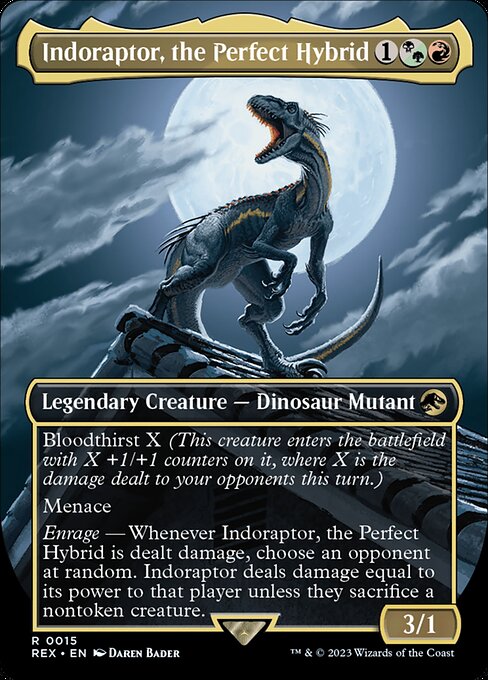
Image courtesy of Scryfall.com
Tech options for control matchups against Indoraptor, the Perfect Hybrid
If you’ve ever sat across the table from a tri-color nightmare wearing menace and a sneer, you know Indoraptor, the Perfect Hybrid isn’t just a bluff card. It’s a deliberate test of a control plan: can you slow the tempo, manage a dynamic threat, and still win through card advantage and flawless sequencing? With a mana cost of {1}{B/G}{R}, this legendary Dinosaur Mutant from the Jurassic World Collection Rex set thrives on flexible, damage-forward play and punishing your opponent for overextending. The ability table reads like a design anthem for modern control: Bloodthirst X enters with X +1/+1 counters; Menace makes it hard to answer cleanly; Enrage punishes damage dealt to Indoraptor by forcing your opponent into tough choices. It’s a spicy reminder that even a control shell must plan for the biggest, ugliest threats in the room. 🧙♂️🔥
In one-on-one formats, Indoraptor becomes a moving target for your disruption suite. It’s a 3/1 with Menace that can snowball into a surprising behemoth if you so much as dent your opponent’s life total in the turn you play it. The Enrage trigger creates a cascade of decisions: deal damage to Indoraptor and potentially push the opponent to sacrifice a creature, or hold back and let the blockerless menace poke away at the board. The tri-color identity (Black, Green, Red) also invites a broad toolbox, which is both a blessing and a tricky constraint for control players who want clean, efficient answers. In practice, you’ll lean on a balanced mix of disruption, targeted removal, and board-impact spells to keep Indoraptor from becoming a late-game engine. ⚔️
Disruption-first approach: deny the equation
- Counterspells and permission to shut down the plays that enable Indoraptor’s growth or protect its path to the battlefield. The goal is to land fewer threats of your own while keeping its arrival imperceptibly slow.
- Discard and hand disruption (Duress, Inquisition-style effects) to strip away protection or other pieces your opponent might need to keep the board stable.
- Selective removal that hits Indoraptor on its terms—cheaper, efficient answers that don’t overcommit your mana or tilt the game toward a bloodthirst-filled late game.
Control isn’t about racing to a big board; it’s about delivering the right answer at the exact moment. Indoraptor asks for patience, then a precise exhale when the time is right. 🧙♂️
Damage timing and Enrage-aware play
Bloodthirst makes Indoraptor a potential late-game hurricane, but here’s the twist: damage that you deal to your opponent this turn fuels its first entry into the battlefield. If you’re comfortable keeping a tight leash on how much direct damage you push, you can keep Indoraptor relatively lean and manageable. On the other hand, if your control shell has ways to safely push a little damage for a powerful swing on a later turn, Indoraptor can flip into a victory engine you didn’t quite see coming. The Enrage trigger adds a clock to your opponent’s decision-making: do they sacrifice a creature now to blunt damage, or let Indoraptor threaten them on the next attack step? It’s a high-stakes dance that rewards meticulous tempo control. 💎
Board management that denies scope and swing
Because Indoraptor is a menace and a threat with built-in growth potential, you’ll want a mix of board wipes, bounce effects, and defensive stances that reset the board on your terms. Wipes that don’t immediately overcommit your own resources are ideal, since you’re often dealing with a fragile, damage-based growth engine. Beta-tested control lines include:
- Mass removal that reestablishes the scene while keeping you ahead on card economy.
- Bounce or temporary removal to buy a turn and prevent Enrage damage from piling up too quickly.
- Fog-style or damage-prevention effects to blunt combat damage and keep Indoraptor from ever hitting the threshold that fuels its growth.
Metagame considerations and sideboarding
In multi-format contexts where Indoraptor slips into the mix, sideboarding becomes a chess match of its own. You’ll want additional interaction against not just Indoraptor, but the broader threats that tend to orbit a tri-color control shell. Consider extra discard effects, more targeted removal options, and perhaps a few extra draw-and-answer engines to maintain parity as the game drags into the late turns. The key is to stay flexible: don’t overcommit to a single plan, and be ready to pivot toward card advantage and inevitability while keeping Indoraptor in line. 🎨
Putting it all together
Indoraptor, the Perfect Hybrid asks you to balance risk with precision. As a control player, you’ll lean on disruption to keep the dinosaur off the battlefield long enough to develop your own plan, then ride a steady stream of answers and card advantage to a favorable endgame. The card’s colorful identity makes it a perfect candidate for a multi-color control shell—that flexibility is your gateway to patient, purposeful play. And yes, the thrill of navigating a tempo-heavy matchup with a tri-color plan is exactly the kind of thrill that makes MTG fans grin—from nostalgic creature design to modern, edge-of-seat decision points. 🧙♂️💥
For a little real-world tech flair that blends into your daily setup, check out this Neon Gaming Mouse Pad: it’s a stylish desktop companion that keeps your control station sharp when you’re tuning sideboards or counting cards late at night. Neon Gaming Mouse Pad Rectangular 1/16in Thick Non-Slip